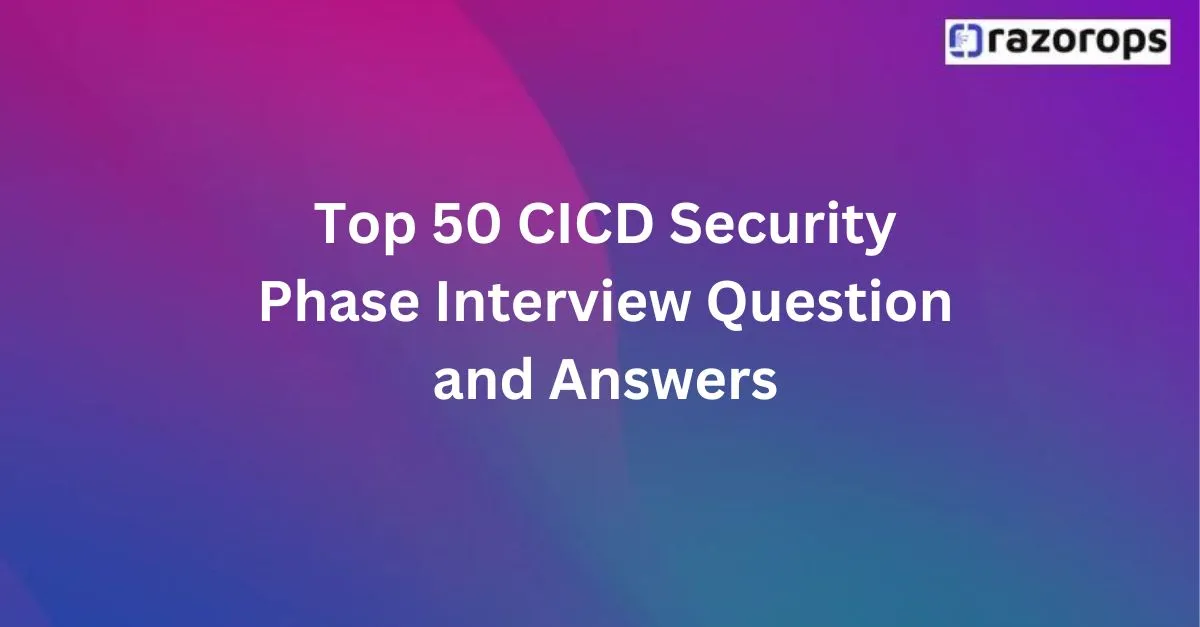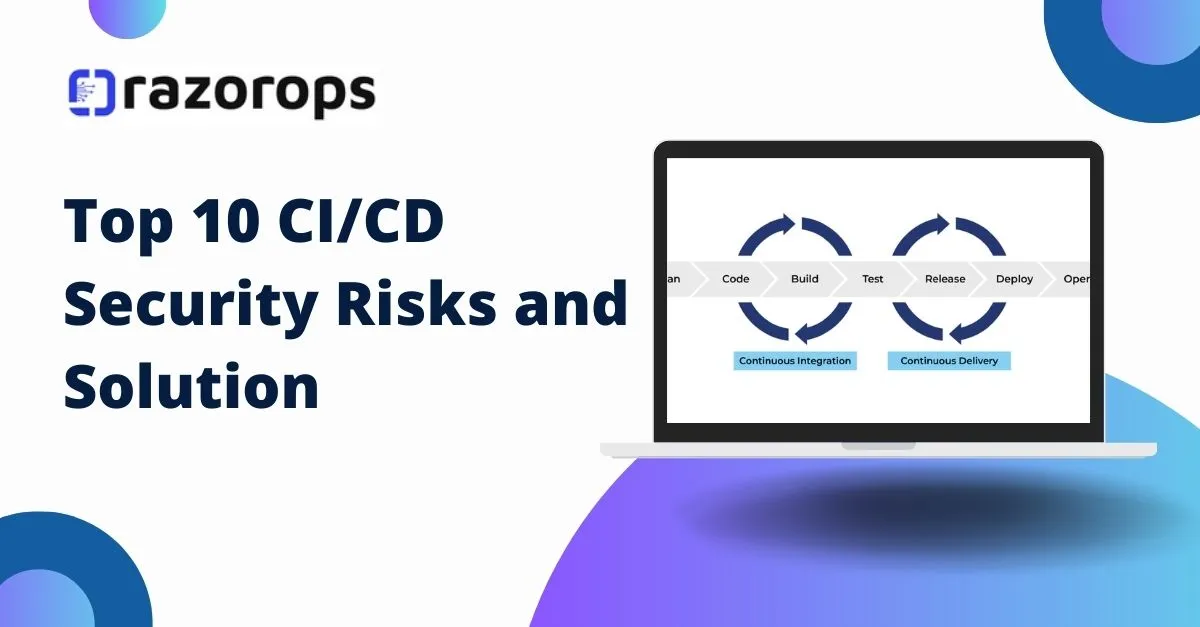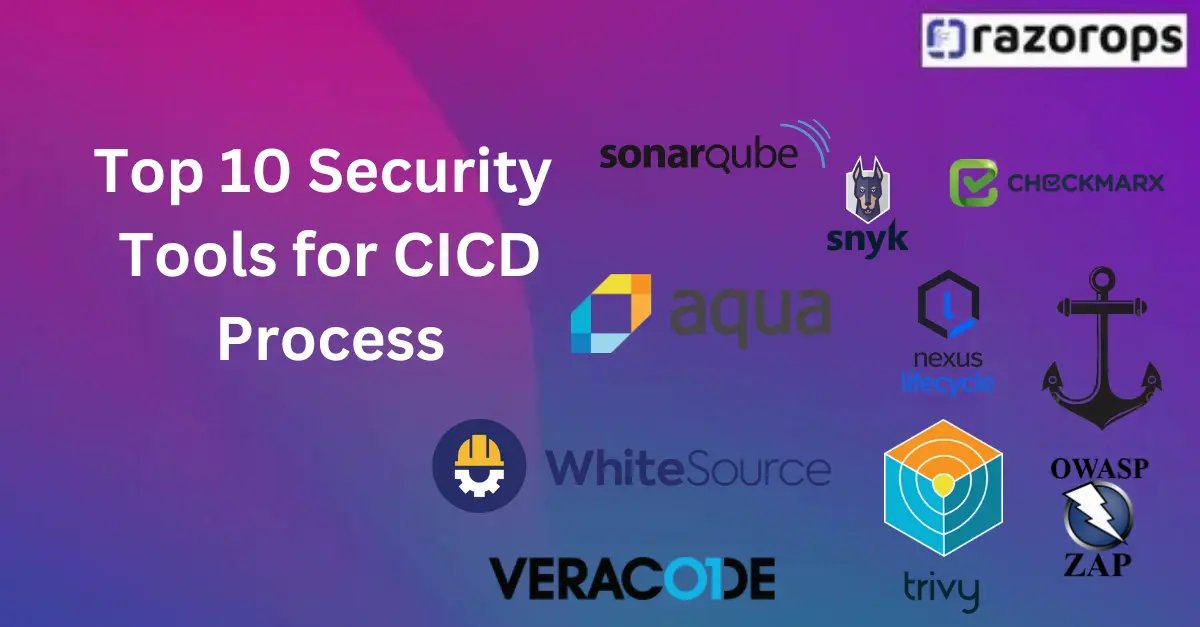Top 50 CICD Security Phase Interview Question and Answers

Top 50 CICD Security Phase Interview Question and Answers
1. What is CI/CD and why is it important for security?
CI/CD is a method to frequently deliver apps to customers by introducing automation into the stages of app development. The main concepts are continuous integration, continuous delivery, and continuous deployment. It is crucial for security because it allows for continuous and automated testing of code, ensuring vulnerabilities are identified and addressed quickly.
2. What are some common security challenges in CI/CD pipelines?
Common challenges include handling secrets securely, ensuring code integrity, dependency vulnerabilities, misconfigurations, and ensuring compliance with security policies.
3. How do you secure sensitive data, such as credentials and API keys, in a CI/CD pipeline?
Sensitive data can be secured using secrets management tools like HashiCorp Vault, AWS Secrets Manager, or Azure Key Vault. Environment variables and encrypted files can also be used.
4. What is a secure software development lifecycle (SDLC)?
A secure SDLC integrates security at every phase of the software development process, from planning and design to implementation, testing, deployment, and maintenance.
5. Explain the concept of “shift-left” security.
“Shift-left” security refers to the practice of integrating security measures early in the development process, rather than addressing them at the end of the cycle. This helps in identifying and fixing vulnerabilities sooner.
6. What are some tools used for static code analysis in CI/CD?
Tools for static code analysis include SonarQube, Fortify, Checkmarx, and Veracode.
7. How do you integrate static application security testing (SAST) into a CI/CD pipeline?
SAST can be integrated into the CI/CD pipeline by including it as a step in the build process, ensuring that code is analyzed for vulnerabilities before being built or deployed.
8. What is dynamic application security testing (DAST)?
DAST is a method of testing the running application for security vulnerabilities. It involves executing the application and testing its interfaces, such as web services and APIs.
9. How can DAST be integrated into a CI/CD pipeline?
DAST can be integrated by running automated tests against a deployed version of the application in a staging environment, identifying vulnerabilities that may not be evident in the source code.
10. What are some best practices for handling dependencies in CI/CD?
Best practices include using dependency management tools like npm, Maven, or Gradle, regularly updating dependencies, using vulnerability scanning tools like Snyk or OWASP Dependency-Check, and avoiding dependencies with known vulnerabilities.
11. How do you ensure that third-party libraries are secure?
By using tools that scan for vulnerabilities, keeping libraries updated, and using libraries from reputable sources.
12. What is the principle of least privilege and how does it apply to CI/CD?
The principle of least privilege means providing only the minimum necessary access to users and systems. In CI/CD, this ensures that services and individuals have only the permissions they need to perform their tasks, reducing the risk of unauthorised access.
13. What is the purpose of a security gate in a CI/CD pipeline?
A security gate is a checkpoint that ensures certain security criteria are met before allowing the process to proceed. This might include passing security scans, code reviews, or compliance checks.
14. How do you conduct a security review of your CI/CD pipeline?
By reviewing the pipeline configuration, ensuring proper access controls, using automated security tools, and conducting regular audits and vulnerability assessments.
15. What is container security and why is it important in CI/CD?
Container security involves securing the containerized environments, including the applications, underlying infrastructure, and orchestration platforms like Kubernetes. It is important because containers are often used in CI/CD to ensure consistent environments across development, testing, and production.
16. How do you scan container images for vulnerabilities?
By using tools like Docker Bench, Clair, Trivy, or Aqua Security that scan container images for known vulnerabilities.
17. What are some best practices for securing Kubernetes in a CI/CD pipeline?
Best practices include using RBAC for access control, applying network policies, regularly scanning for vulnerabilities, ensuring secrets management, and using tools like kube-bench for compliance checks.
18. How can you ensure the integrity of the code being deployed in CI/CD?
By using version control systems, implementing code signing, ensuring automated testing, and using tools that validate checksums or hashes of the code.
19. What is continuous security monitoring and how is it implemented in CI/CD?
Continuous security monitoring involves regularly scanning and monitoring the application and its environment for security threats. This can be implemented by integrating security tools that continuously scan for vulnerabilities and log monitoring for any unusual activity.
20. How do you handle security incidents in a CI/CD pipeline?
By having an incident response plan that includes detection, containment, eradication, recovery, and lessons learned. Integrate monitoring tools to detect incidents early and automate responses where possible.
21. What is Infrastructure as Code (IaC) and how do you secure it?
IaC is the management of infrastructure through code instead of manual processes. It can be secured by using version control, automated testing, scanning for misconfigurations, and enforcing security policies through tools like Terraform, AWS CloudFormation, and Azure Resource Manager templates.
22. How do you manage and rotate secrets in a CI/CD pipeline?
By using secrets management tools that automate the rotation of secrets, ensuring secrets are not hardcoded, and implementing policies for regular secret updates.
23. What are some common vulnerabilities in CI/CD pipelines?
Common vulnerabilities include hardcoded credentials, insecure dependencies, lack of encryption, inadequate access controls, and misconfigured environments.
24. How can you enforce compliance in a CI/CD pipeline?
By using tools that automatically check for compliance with security standards, integrating these checks into the pipeline, and ensuring regular audits.
25. What is a build artifact and how do you ensure its security?
A build artifact is a file or set of files resulting from a build process, such as binaries, libraries, or packages. Security can be ensured by storing artifacts in secure, access-controlled repositories and scanning them for vulnerabilities before deployment.
26. How do you secure the CI/CD pipeline itself?
By securing the CI/CD tools and environments, implementing strong access controls, using secure communication channels, and ensuring the pipeline is regularly updated and patched.
27. What is DevSecOps and how does it relate to CI/CD?
DevSecOps is the practice of integrating security into every phase of the DevOps lifecycle. In CI/CD, it means incorporating security checks and balances throughout the pipeline to ensure secure code delivery.
28. How do you ensure compliance with GDPR or other data protection regulations in a CI/CD pipeline?
By implementing data protection policies, ensuring data minimization, using encryption, conducting regular audits, and integrating compliance checks into the CI/CD pipeline.
29. What are the security implications of using open-source software in CI/CD?
Open-source software can introduce vulnerabilities if not properly managed. Security implications include potential for unpatched vulnerabilities, malicious code, and licensing issues.
30. How do you secure the communication between different stages of a CI/CD pipeline?
By using secure communication protocols such as HTTPS, SSH, or VPNs, ensuring proper authentication and encryption, and limiting network access to only necessary services.
31. How can you implement role-based access control (RBAC) in a CI/CD pipeline?
By defining roles with specific permissions and assigning users to these roles, ensuring that users only have access to the resources and actions necessary for their job functions.
32. What is the importance of logging and monitoring in CI/CD security?
Logging and monitoring help detect and respond to security incidents, ensure compliance, and provide insights into the performance and security of the pipeline.
33. How do you ensure that CI/CD tools themselves are secure?
By keeping tools up to date, configuring them securely, using strong authentication methods, and regularly auditing their usage and configuration.
34. What are some common misconfigurations in CI/CD pipelines and how do you avoid them?
Common misconfigurations include improper access controls, insecure storage of secrets, and lack of encryption. These can be avoided by following best practices, using automated configuration management tools, and conducting regular reviews and audits.
35. How do you manage dependencies securely in a CI/CD pipeline?
By using dependency management tools, regularly updating dependencies, scanning for vulnerabilities, and ensuring the use of trusted sources.
36. What are some best practices for securing build environments?
Best practices include isolating build environments, using minimal base images, scanning for vulnerabilities, implementing access controls, and monitoring for unusual activity.
37. How can you use automation to enhance security in a CI/CD pipeline?
Automation can be used to perform regular security scans, enforce policies, rotate secrets, and respond to security incidents, ensuring consistency and reducing the risk of human error.
38. What is an SBOM (Software Bill of Materials) and why is it important for security?
An SBOM is a detailed inventory of the components in a piece of software, including dependencies. It
38. What is an SBOM (Software Bill of Materials) and why is it important for security?
An SBOM is a detailed inventory of the components in a piece of software, including dependencies. It is important for security because it provides visibility into the components used, allowing for the identification and management of vulnerabilities in third-party libraries and dependencies.
39. How do you ensure the security of artifacts in a CI/CD pipeline?
By using secure artifact repositories, applying access controls, signing artifacts to verify integrity, and scanning artifacts for vulnerabilities before deployment.
40. What are some methods for ensuring the security of deployment environments?
Methods include using infrastructure as code (IaC) for consistent and secure environment configurations, applying network segmentation, enforcing access controls, and using automated compliance checks.
41. How can you ensure compliance with security standards in a CI/CD pipeline?
By integrating security standards into the CI/CD pipeline, using tools that enforce compliance checks, conducting regular audits, and staying updated with the latest security guidelines and best practices.
42. What is the role of container orchestration tools like Kubernetes in CI/CD security?
Container orchestration tools help manage and secure containerized applications by providing features like automated deployments, scaling, and management of container clusters. They also offer security features like network policies, role-based access control (RBAC), and secrets management.
43. How do you manage and mitigate vulnerabilities in container images?
By regularly scanning container images for vulnerabilities using tools like Clair, Trivy, and Aqua Security, applying updates and patches, and following best practices for creating secure container images.
44. What is a CI/CD pipeline and how does it improve software development security?
A CI/CD pipeline is a series of automated processes that enable developers to build, test, and deploy code. It improves software development security by automating security checks, ensuring consistent and repeatable builds, and quickly identifying and addressing vulnerabilities.
45. How can you prevent unauthorized access to CI/CD pipelines?
By implementing strong authentication and authorization mechanisms, using RBAC, ensuring secure network configurations, and regularly auditing access logs and permissions.
46. What are some best practices for securing CI/CD pipelines in a cloud environment?
Best practices include using cloud-native security tools, encrypting data in transit and at rest, applying the principle of least privilege, regularly updating and patching, and using secure configurations for cloud services.
47. How do you handle the security of third-party integrations in CI/CD pipelines?
By carefully vetting third-party tools and services, using secure APIs, applying access controls, regularly updating integrations, and monitoring their usage for unusual activity.
48. How do you ensure the integrity and security of code during the build process?
By using version control systems, applying code signing, performing static and dynamic code analysis, and using automated tests to verify code functionality and security.
49. What is a canary deployment and how does it enhance security?
A canary deployment is a strategy where a new version of an application is gradually rolled out to a small subset of users before being fully deployed. It enhances security by allowing the detection and mitigation of issues, including security vulnerabilities, in a controlled environment.
50. How do you use logging and monitoring to enhance the security of CI/CD pipelines?
By implementing comprehensive logging and monitoring solutions, setting up alerts for suspicious activities, regularly reviewing logs, and using monitoring tools to detect and respond to potential security incidents in real time.



